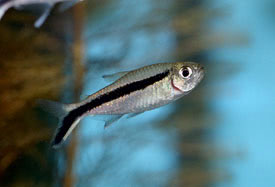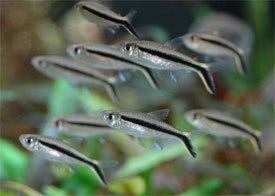
 Magyarul / Hungarian
Magyarul / Hungarian


- Scientific name: Thayeria boehlkei
- Common name: Blackline penguinfish
- Group: Characins
- Habitat: South America; Peru and Western Brazil, the Amazon basin.
- Size: 8 cm
- Biotope: Found in slow moving waters of the Amazon basin, among scattered patches of plants.
- Social behavior: A peaceful, schooling fish recommended for a community tank. Keep this fish in groups.
- Diet: Flakes, live, insect larvae, Brine Shrimp, Tubifex .
- Breeding: Quite easy
- Tank: Minimum 90 litres
- Population: 6-7 fish for 120 litres
- Decoration: The tank should be well-planted and have a cover of floating plants to diffuse the lighting. Leave open swimming areas.
- Temperature: 22-26°C
- pH: 6,5-7,2.
- Hardness: 4,5-8,5 NK°
- Lifespan: 4-5 years
Description: A rather long fish with much lateral compression. The upper and lower profiles are very similar in appearance. The bottom of the rear fin (Caudal) is slightly longer, giving the penguin its one of a kind look.
A black longitudinal stripe starts at the end of the gill cover plate and runs all the way to the base of the Caudal fin where it turns downward to the bottom tip of the tail fin. A shinny Gold colored line runs on either side of the thicker Black stripe. The upper main body color is a gold or bronze color and the lower body is a silver to gray color. The fins are clear with a slight Yellow tint and the front of the Anal fin has a milky front.
An easily cared for fish the penguin is omnivorous accepting flake, frozen and live food. The addition of some vegetable matter in the food is beneficial. They are adaptable to a wide range of water conditions, although it has been said that they are sensitive to high Nitrate levels. The tank should be loosely planted with plenty of open space for swimming. They swim at an angle facing up and are a schooling fish and should be kept in groups of at least six. An all around winner for the community aquarium.
A very prolific breeder often having broods of over 1000, a fairly large breeding tank is needed. The water should be soft and on the acidic side (5.5). The substrate should consist of fine leafed plants to catch the large number of eggs. Females when ready to spawn have a very distended belly due to the large number of eggs. After spawning the pair should be removed and a portion of the water should be changed due to the large amount of sperm released by the male which could foul the water. The eggs hatch in less than a day and the fry are very small and need to be fed the smallest of foods available.





















